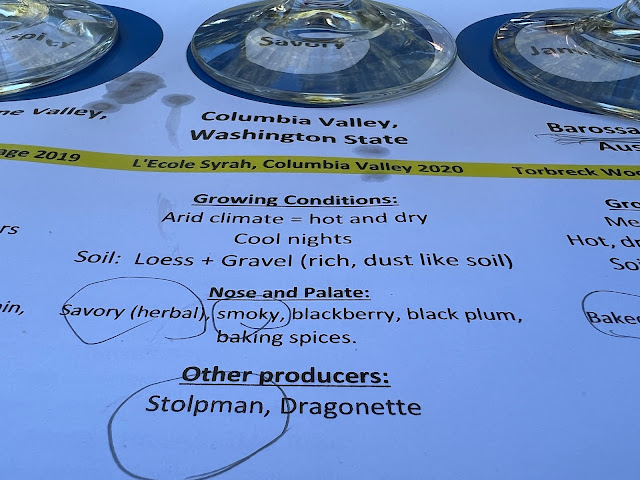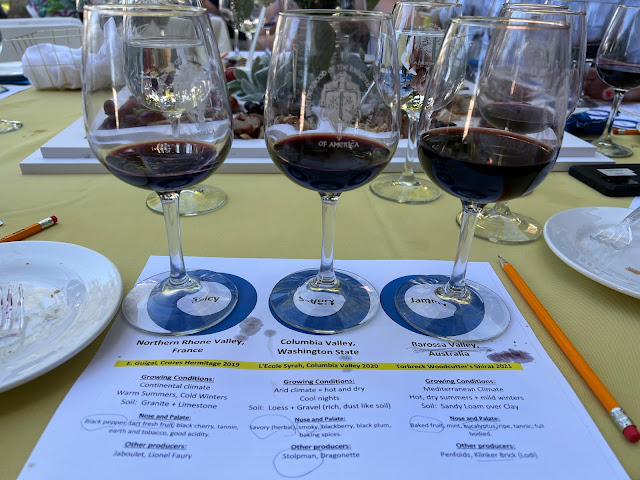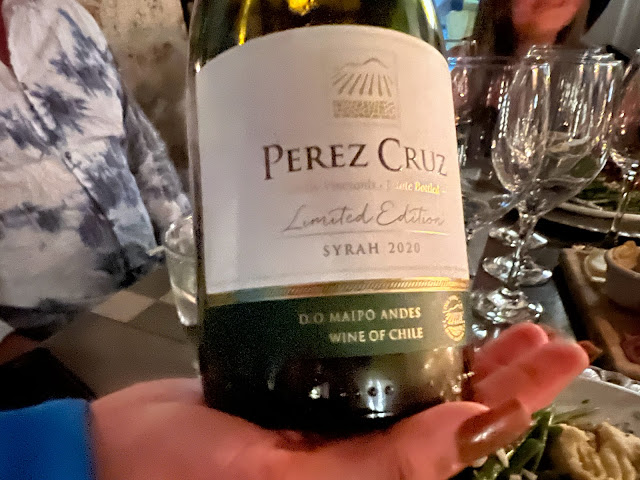I have always found Syrahs to be quite interesting. Syrah, an international red grape variety, is the sixth-most grown grape in the world. In 1999, analysis reveled that Syrah is the offspring of two obscure grapes (Dureza and Mondeuse Blanche) from southeastern France. Syrah is used to produce single varietal wines, and blends. Syrah and Shiraz are the same grape. Syrah is how the variety is commonly referenced, with Shiraz being how it is referred to in Australia. Shiraz is also used for wines with an Australian Shiraz's style. This post will focus on Syrah styles that I have encountered at two wine escapades. While there maybe Syrah styles for regions around the world I realize these styles are guidelines. It's the exceptions, or aha moments that make the wine world so interesting! Let the Syrah/Shiraz escapedes begin.
Contemplating Syrah/Shiraz, Aqua Antigua © Spaswinefood
Syrah is grown around the world from France (Côtes du Rhône: Cornas, Hermitage, St. Joseph, Côte-Rôtie) to New World wine regions such as: Chile, South Africa (Stellenbosch, Paarl, Franschhoek), New Zealand, United States (CA- Paso Robles, Santa Barbara, Napa, and Sonoma; and WA- Columbia Valley), and in Australia ( Barossa, Heathcote, Limestone Coast, Hunter Valley, Margaret River, Adelaide Hills, Clare Valley and McLaren Vale). This post will share insights into from two recent wine events.

KOV (Knights of the Vine) Syrah Style Tasting © Spaswinefood
Wine Escape One: Knights of the Vine (KOV)
One Sunday afternoon last summer we gathered at a members home for a Syrah wine tasting focusing on wine styles. Obviously, style and flavor profile of Syrah wines are influenced by the climate where the grapes are grown. A simplistic overview of climatic influence on Syrah styles follows:
Moderate climates, such as northern Rhone Valley and Walla Walla AVA, Washington State, the wines tend to be medium to full-bodied, medium to high levels of tannins, with blackberry, mint and black pepper aromas. Hot climates, such as Australia's Barossa Valley, the wines tends to be full-bodied with softer tannins, jammier fruit, and aromas of licorice, anise and earthy leather.
Before the Tasting three different Syrahs/Shiraz that afternoon we socialized with old friends, over a glass of Chapoutier Cotes du Rhone Belleruche Blanc 2021.

Description of Chapoutier Cotes du Rhone Belleruche Blanc 2021 © Spaswinefood
Sommelier, Master Lady Sudsy Torbeck lead us through a three-flight tasting and discussion of following three Syrahs/Shiraz:
1. E. Guigal Croze Hermitage
2. L'Ecole 41 Columbia Valley Syrah
3. Torbreck Woodcutters Shiraz
Wines Served, KOV Event © Spaswinefood
That afternoon I was excited to explore these Syrahs for their aromas and flavors. Wine Styles of Syrah/Shiraz © Spaswinefood
Aromas and Flavors of Syrah/Shiraz © Spaswinefood
The three Syrahs showed Spicey, Savory and Jammy wine styles.
Overiew of Syrah/Shiraz Wines Tasted © Spaswinefood
1. E. Guigal, Croze Hermitage, Rhone Valley 2019
E. Guigal, Croze Hermitage, Rhone Valley 2019 © Spaswinefood
The E. Guigal, Croze Hermitage was a good example of Syrah from the Northern Rhone, which is known for Syrahs with rich aromas and flavors. Regrettably, many warmer climatic regions have mass produced Syrahs. When you mass produce Syrah however, it commonly lacks the characteristics or wildness for which the grape is well known. The result is many Syrahs ended up being used in red blends. Chomiskey has written on the reasons for the need to focus on the production of quality Syrah.
2. L'Ecole 41 Syrah, Columbia Valley 2020
L'Ecole 41 Syrah, Columbia Valley 2020 © Spaswinefood
L'Ecole 41, Syrah 2020 is a good indication of a savory profile from the Columbia Valley. The winery description:
This full-bodied Syrah shows robust and pronounced aromas of blackberry, black currant, violets, black peppercorn, Herbes de Provence, and licorice. Spiced dark fruit flavors reveal themselves on the palate finishing with a mouth-filling, savory richness. (L'Ecole 41)
For one of my 2018 articles I wrote this:
I was to board a bus, with the same color placard as the dot, and the bus would take us to a dinner at a mystery location. When your mystery dinner turns out to be hosted by L’Ecole 41 and Woodward Canyon wineries, then you know that you are in great hands.
 |
| L'Ecole N° 41, Walla Walla 2018 © Spaswinefood |
This outing was not my first introduction to L’Ecole 41 and Woodward Canyon wineries. It was however, my first opportunity to meet the faces behind the wines. Washington State's Walla Walla Valley AVA has been a rising star in the wine world for awhile. The first wine making in the area dates back to 1840's. Wine making disappeared here during Prohibition. Fortunately the area experienced a rebirth in 1970's with the establishment of Leonetti Cellars. This was followed by arrival of Woodward Canyon in 1981 and L' Ecole N° 41 in 1983. The appellation AVA was granted in 1984. Naturally, Spaswinefood was excited to return to L’Ecole 41 and Woodward Canyon wineries, to gain further insights into what makes this wine region so very special.
I would also like to note that Stolpman Santa Barbara's Ballard Canyon AVA produces quality Syrah. This AVA decided to focus its efforts on producing top quality Syrahs. Boutique wineries in Ballard Canyon AVA achieved this goal by engaging in small scale production of Syrahs with richer aromas and flavors. This decision has come after, not only doing research on what grows best in the AVA but, it is the collective vision for the AVA. In keeping with this goal 50% of the AVA is dedicated to the growing of Syrah. Dragonette Cellars, is also located in Santa Barbara wine country.
3. Torbreck Woodcutters Shiraz, Barossa Valley 2021
Torbreck Woodcutters Shiraz, Barossa Valley 2021 © Spaswinefood
This 2021 vintage gets good reviews by Vivino users and critics. While the description works for this Barossa Valley Shiraz I believe that this is not true for all. After an earlier visit to the Barossa Valley I wrote the following:
Barossa Valley
It was so easy to fall in love with the Barossa Valley Wine Region, South Australia. As we traveled throughout the region’s towns, villages and hamlets we grew to love it more. This region is not only home to over 80 cellar doors and 150 wineries but also, it offers so many culinary delights, ranging from farmers markets to fine dining. Similarly, you will find accommodations for every budget from student hostels and caravan parks to romantic country cottages, boutique hotels and more.
 |
| Barossa Valley, Australia © Spaswinefood |
The area rivals any top wine region in the world. It is easily accessible by car, bus and train from Adelaide. Adelaide is served by domestic and international flights. Barossa Valley also makes a perfect base for exploring the nearby wine regions: Adelaide Hills, Clare Valley and Murray River.
Charles Melton is where tradition and wine making style are a perfect blend. Bruce Schoenfeld writing for Saveur definitely hits the nail on head when he described wines, such as Melton's, as having "freshness and fineness far more than heft". Moreover, I rather liked his description of the Barossa Valley wine scene. My personal observations are that during my winery visits I tasted plenty of jammy Shiraz wines that were high in alcohol. In fact some wineries prided themselves in making wines in this style. Fortunately there is also a wonderful diversity of other wine styles throughout the valley.
Taking a Look at Syrah/Shiraz Wine Styles © Spaswinefood
Attending the KOV wine tasting gave me the perfect opportunity to engage in an inquiry; and to also reflect on my earlier experiences with Syrah. Next, I will review two Chilean Syrahs served at a recent wine dinner.
Aqua Wine Room, Antigua © Spaswinefood
Wine Escape Two: Wine Dinner Aqua, Antigua, Guatemala
Last week I enjoyed a wine dinner at Aqua Restaurant. Sommelier Juan Jansa from El Mercat introduced six wines that evening.
Juan Jansa, El Mercat © Spaswinefood
Two of the wines introduced by Juan were Perez Cruz, Syrahs from Chile. These Syrahs motivated me to explore styles of Chilean Syrah. The Wine Diplomats give this overview of Chilean Syrah:
Syrah is the 5th most planted red wine grape in the world and the 6th most planted grape overall in Chile. In Chile, it plays a supporting role in the Central Valley wine regions in Bordeaux blends. In addition, most of these same producers also produce varietal versions, but they’re rarely their flagship wines. On the other hand, Syrah is more important as a monovarietal wine for producers in Northern Chile in places like Atacama and the Elqui Valley, and along the coast for cool-climate Syrah in the San Antonio Valley and Casablanca.
In terms of style, rarely does a Chilean Syrah act like an Australian Shiraz, which tends to be higher in alcohol, wood and ripeness. Similarly, they’re usually less ripe, alcoholic and wood influenced than California Syrah. Compared to the Northern Rhone in France, they’re less terroir and vintage driven. The amount of oak and overall style can vary from producer to producer and depend on the price range in all these places though. (Winediplomats)
I found that the above description a helpful framework to review the two wines from the same producer (Perez Cruz) served that evening. Perez Cruz has a rich heritage in winemaking. Both wines came from Main-Andes, a sub-region of Maipo Valley, which is within Chile's Central Valley.
Perez Cruz, Syrah Limited Edition, DO Maipo Andes 2020
The first wine is light in color, or translucent. This vintage is 92% Syrah, 6% Grenache, and 2% Mourvèdre -- Chile requires for varietal name to appear on the label a wine must contain 85% of the varietal listed, and as well at least 85% from the designated vintage year. On the nose there were some black fruit, spicy, and oak notes. In terms of taste it was on the dry side, smooth to medium tannins, and low to medium acidity. Both critics and Vivino users gave this wine good reviews.
Perez Cruz, Syrah Limited Edition, DO Maipo Andes 2020 © Spaswinefood
This Limited Edition Syrah fits within the overall description provided by Winediplomats
..... rarely does a Chilean Syrah act like an Australian Shiraz, which tends to be higher in alcohol, wood and ripeness. Similarly, they’re usually less ripe, alcoholic and wood influenced than California Syrah. Compared to the Northern Rhone in France, they’re less terroir and vintage driven.
Perez Cruz, Laguai, DO Maipo Andes 2019
In contrast the second wine, a Syrah blend was a more structured and complex wine. It was produced from grapes grown in some of Perez Cruz best vineyards. The 2019 vintage is a blend of 48% Syrah, 30% Cabernet Sauvignon, and 23% Carmenere. On the nose there were very more intense black fruit, spicy and oak notes than the first wine. In terms of taste it was drier with bolder tannins, and good acidity. Again, this wine get good scores from both critics and Vivino users.
Perez Cruz, Laguai, DO Maipo Andes 2019 © Spaswinefood
The second wine fits within the Central Valley wine regions profile for Bordeaux style blends.
These two Perez Cruz Syrahs that I tasted were very different. I enjoyed the contrast in style. Both wines are available in Guatemala from El Mercat.
Qué Syrah, Shiraz
Both the above two Chilean Syrahs served at Aqua's wine dinner and those introduced at the KOV event illustrate the diversity of Syrah/Shiraz styles.
Syrah/Shiraz, KOV © Spaswinefood

Que Syrah/Shiraz © Spaswinefood
Both of the above Syrah/Shiraz escapedes illustrate the rich diversity in Syrah styles, both across and within wine regions around the world. Special thanks to the sommeliers for sharing their insights into these wines. I invite you to join me in my wine travels at Wine Travels with Dr. Sharon, and at Spaswinefood on Twitter and Facebook. I am so looking forward to sharing more on my vine-filled explorations.
CHEERS!
Sharon
February 2024
Antigua, Guatemala
© Spaswinefood
Aqua Wine Room, Antigua © Spaswinefood
Que Syrah, Que Shiraz © Spaswinefood
A Little Syrah/Shiraz & Chocolate © Spaswinefood


























No comments:
Post a Comment